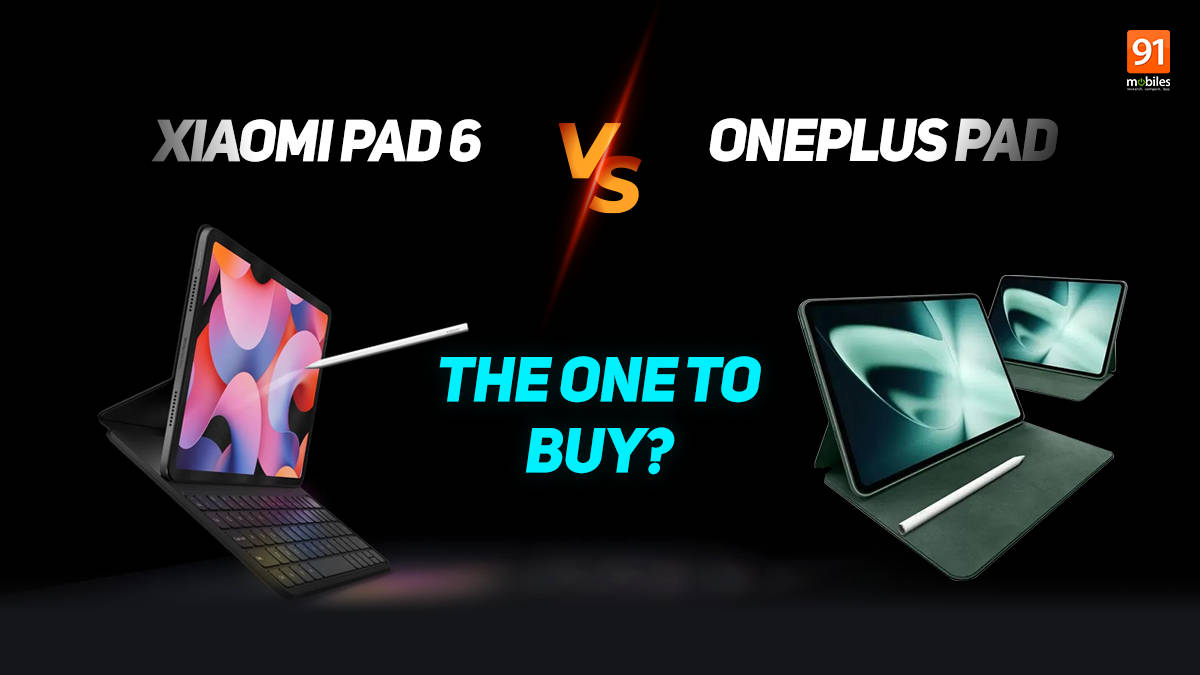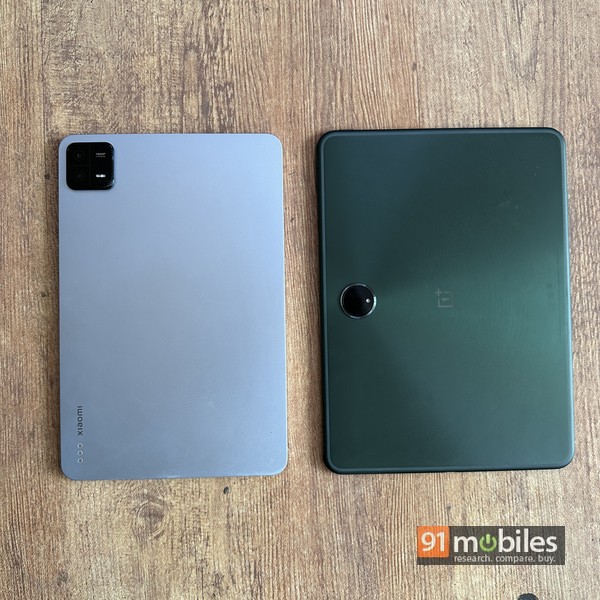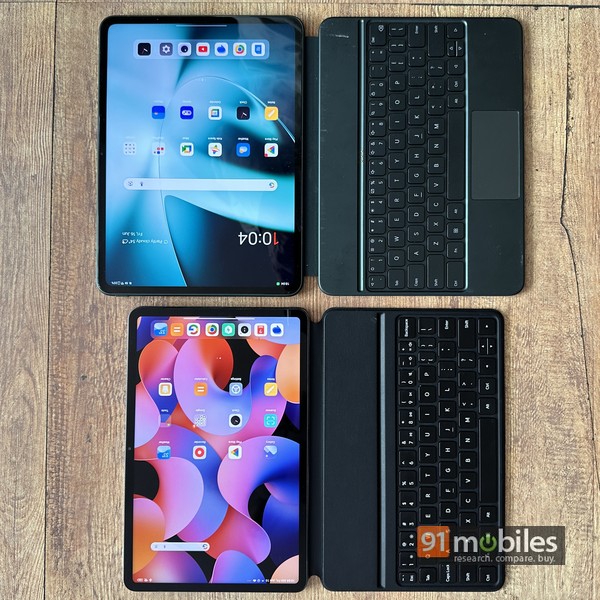
Xiaomi is back in the slate business and its latest, the Xiaomi Pad 6 is perhaps one of the best near-flagship level tablets one can get if one is on a tight budget (say around Rs 30,000 – you no longer get a new iPad for that much!). But standing in its way is OnePlus’ very promising and powerful debut in the tablet market barely a couple of months ago. The OnePlus Pad might come with a higher price tag than the Xiaomi Pad 6, but it has a few aces of its own up its gadget-y sleeves, and still is priced lower than the new Apple iPad (the iPad 10th Gen). So which of these two Android budget flagship tabs should you be going for? Save a few bucks and get the Xiaomi Pad 6 or put down the money and Never Settle for anything less than a OnePlus Pad? Let us work it out for you.
Table of Contents
Design and appearance: Chalk and cheese!

There is absolutely zero chance of you getting confused between these two tablets. They both have glass fronts and metallic frames, but are very different in just about every regard. The Xiaomi Pad 6 is more compact and has straight sides and a flat back and comes in light blue and grey, while the OnePlus Pad comes in green and has curved sides and a slightly curved back. The Xiaomi Pad 6 has a square-shaped camera unit (similar to the Xiaomi 13 Pro) which is on the top left corner, while the OnePlus Pad comes with a circular camera unit lodged in the centre of the left side. The back of the Xiaomi Pad 6 is plain, while the OnePlus Pad has subtle concentric circles around the camera unit. They are even shaped differently – the OnePlus Pad is slightly more square-shaped with a 7:5 aspect ratio, while the Xiaomi Pad 6 is more conventionally rectangular with a 16:10 aspect ratio. OnePlus Pad is also significantly bigger than the Xiaomi Pad 6 – 258 x 189.4 x 6.5 mm against 253.9 x 165.18 x 6.5 mm. In terms of weight, the OnePlus Pad is heavier at 552 grams as compared to 490 grams of the Xiaomi Pad 6. Which one looks better is really a matter of preference. The green shade and the camera placement make the OnePlus Pad stand out, while the Xiaomi Pad 6 seems more compact and elegantly understated. Significantly, the Xiaomi Pad 6 comes with IP53 splash resistance, something the OnePlus Pad lacks. It is totally a matter of taste and preference. We are going to give this one to the OnePlus Pad because of its tendency to stand out, but we can see a lot of folks preferring the Xiaomi Pad 6 for its elegant compactness (in fact, one of us did. It’s THAT close).
Winner: OnePlus Pad
Display: Bigger or brighter?
The OnePlus Pad comes with a 11.61-inch display with 2,800 x 2,000 resolution and 144Hz refresh rate, while the Xiaomi Pad 6 comes with an 11-inch display with 2,880 x 1,800 resolution and 144Hz refresh rate. Both are very good displays, but if sheer display size matters, then the OnePlus Pad is the better option. It is not just about the difference in display size on paper, but the fact that the display of the OnePlus Pad is slightly taller and wider as well.

In quality terms, we think the Xiaomi Pad 6 has an edge when it comes to brightness and handling colours (the OnePlus Pad can at times seem a little washed out). It might just be down to the fact that the Xiaomi Pad 6 has a higher pixel density (309 ppi to 296 ppi), but we think the Xiaomi Pad 6 is the better one here.
Winner: Xiaomi Pad 6
Processor, RAM and Storage: Who’s got the gigs?

This is a clash between the MediaTek 9000 chip on the OnePlus Pad and the Qualcomm Snapdragon 870G chip on the Xiaomi Pad 6. They are both slightly old, but still flagship-level chips. In terms of performance, we would say that the MediaTek 9000 has a clear edge, being the newer chip with much higher benchmark scores. The OnePlus Pad scores in the RAM and storage department too. Both tablets come with LPDDR5 RAM and UFS 3.1 storage, but while the Xiaomi Pad 6 has 6GB/ 128GB and 8GB / 256GB variants, the OnePlus Pad has 8GB/ 128GB and 12GB/ 256GB variants. There is only one winner here.
Winner: OnePlus Pad
Gaming and multimedia: Game for entertainment
Both devices are very good at casual gaming, but the more powerful processor of the OnePlus Pad makes it a much better option if you are the type that likes to play Genshin Impact and Call of Duty at high graphics settings. Both tablets also come with quad speakers, but we thought that the Xiaomi Pad 6 delivered better audio in terms of quality – the volume levels are about the same on both. There is not much to separate the two when it comes to watching shows and videos. We would go with the OnePlus Pad for this one, thanks to its more powerful processor, which makes it a better gaming device. But if you mainly want to watch content, then both tablets are similar, and you would need to figure out what matters more to you – the larger display of the OnePlus Pad or the better sound of the Xiaomi Pad 6.
Winner: OnePlus Pad
Software: Who does The Tablet Code better

Both tablets run on Android 13, but there the similarity ends. While OnePlus has used a variant of its clean OxygenOS interface on its tablet, Xiaomi has opted for a tablet-friendly version of MIUI 14. While OxygenOS works just fine on a smartphone, it is actually far too minimalistic for a tablet, and MIUI wins the battle by a clear margin here. You can simply do much more on the Xiaomi Pad 6 right out of the box, whether on its own or with a stylus and keyboard, than you can on the OnePlus Pad, which has kept things a little too basic for comfort. There are more gestures and shortcuts and tablet-oriented tweaks on the Xiaomi Pad 6 than on the OnePlus Pad.
Winner: Xiaomi Pad 6
Stylus and keyboard: For the write types!

One does not generally consider styluses and keyboards when comparing two tablets, but both OnePlus and Xiaomi have promoted theirs so heavily (and Xiaomi is even offering special bundles that include the stylus and keyboard at a special price) that we think these need to be considered. We would say that Xiaomi’s Smart Pen (2nd Generation) has an edge over the OnePlus Stylo, thanks to its two buttons that let it carry out more functions, such as taking a screenshot or even scrolling a page. The Stylo’s two-tap functionality is handy too but can be a little hit-and-miss. Both styluses charge off the side of the tablets, but the Xiaomi Smart Pen comes with a staggering 150 hours of battery life, which is the highest in the industry, and well ahead of the Stylo.

In terms of keyboards, both the Xiaomi Pad 6 Keyboard and the OnePlus Magnetic Keyboard also double up as covers and have a single viewing angle. However, the OnePlus keyboard also has a touchpad, which the Xiaomi keyboard lacks. There are, however, connectivity issues with the OnePlus keyboard from time to time and that touchpad is a two-edged sword: it is convenient but often gets triggered accidentally. What really swings things is the software support for these devices – you can customise shortcuts extensively on the Xiaomi keyboard while the OnePlus keyboard remains a little limited in that regard. The pricing seals this round in favour of the Xiaomi accessories – the Xiaomi Smart Pen (2nd Generation) comes for Rs 5,999, which is more than the OnePlus Stylo which is available for Rs 4,999; but the Xiaomi keyboard at Rs 4,999 is way more affordable than the OnePlus keyboard at Rs 7,999. We are handing this one to the Xiaomi accessories.
Winner: Xiaomi
General usage: Put everyday stuff on the tabs
In routine usage, it is difficult to pick between the two tablets. There is not much difference in terms of handling everyday tasks like Web browsing, social networks, messaging and mai. The Xiaomi Pad 6 is more compact and light, making it slightly easier to carry around and use, but the OnePlus Pad’s larger display does give one a lot more to see and is particularly good for viewing content and images and videos. Both tablets come with 13-megapixel rear and 8-megapixel front cameras, and turn in similar performances – the rear cameras are best used for document scans and the odd snap in good light, while the front cameras are good enough for video calls, but are nowhere near vlog territory (the OnePlus Pad’s front camera has subject tracking but it works only with Google Meet at the time of writing, limiting it). The greater RAM and faster processor of the OnePlus Pad do not really seem to make a discernible difference here. We are calling this one a tie.
Winner: Tie.
Productivity: Because tablets are more than a ‘third screen’ now

The OnePlus Pad might have the entertainment and gaming edge thanks to its bigger display and processor, but when it comes to productivity, the Xiaomi Pad 6 is a clear winner. The tablet is better integrated with its stylus and keyboard accessories and also has much more feature-laden software at the time of writing. You can also connect it seamlessly to a Xiaomi 13 Pro and drag and drop files from it, which is a little limited at the moment but is definitely a step in the right direction. OnePlus has also promised greater connectivity with other OnePlus phones (especially in picking up Internet connections), but it is a bit of a work in progress at the moment. You can also connect the Xiaomi Pad 6 to a TV, monitor or projector using a USB Type-C to HDMI cable, which is a facility the OnePlus Pad lacks at the time of writing. The greater RAM of the OnePlus Pad makes it a smoother multi-tasker than the Xiaomi Pad 6, but at the time of writing, the Xiaomi Pad 6 simply does more! We do wish both had a fingerprint scanner, though.
Winner: Xiaomi Pad 6
Battery life: Charged up for stamina
The OnePlus Pad comes with a 9,510mAh battery, while the Xiaomi Pad 6 comes with an 8,840mAh battery. However, it needs to be remembered that the larger battery of the OnePlus Pad comes with a bigger display. Both tablets come with a decent battery life of 10-12 hours, depending on the level of usage. We think the OnePlus Pad lasted slightly longer on a single charge but the difference is not a massive one. In terms of charging, however, the OnePlus tablet has a clear edge – it comes with support for 67W charging and a 67W SuperVOOC charger in the box, as compared to the 33W charging speed of the Xiaomi Pad 6, which comes with a 33W charger. The difference is clear in the charging times – the OnePlus Pad gets charged in under 90 minutes in spite of having a larger battery, while the Xiaomi Pad 6 gets charged in about 100-105 minutes. The OnePlus Pad wins this one.
Winner: OnePlus Pad
Price: How much?
This is a cakewalk. The Xiaomi Pad 6 is available at Rs 26,999 for 6GB/ 128GB and Rs 28,999 for 8GB/ 256GB, while the OnePlus Pad is available at Rs 37,999 for 8GB/ 128GB and Rs 39,999 for the 12GB/ 256GB variant. The OnePlus Pad does have a 12GB RAM variant which the Xiaomi Pad lacks entirely, but the price differential between the tablets is significant. Xiaomi in fact has even special productivity bundles which offer the 8GB/ 256GB Xiaomi Pad 6 along with a Smart Pen (2nd Generation) and keyboard for Rs 36,997, which is STILL lower than the starting price of the OnePlus Pad. There is only one winner here.
Winner: Xiaomi Pad 6
Verdict: Which one to buy?

This is a very close call. In the ten parameters we measured, the OnePlus Pad won four, Xiaomi won five and one was tied between the two. If we had to keep it really simple, we would say that the Xiaomi Pad 6 is the best option for those who want to do more with their tablets right out of the box, and want to get a tablet and a stylus and keyboard, all for under Rs 40,000. The OnePlus Pad is for those who are planning to do a lot of gaming on their devices or have plans to do more with that more powerful processor and RAM. As of now, we would have to say that its pricing (and that of its accessories) gives the Xiaomi Pad 6 an edge over the OnePlus Pad. Being a OnePlus device, we are reasonably sure that the OnePlus Pad will catch up with the Xiaomi Pad 6, or at least closer to it, in software functionality terms, but as of now the Xiaomi Pad 6 offers better value for money. That said, if it is processing power, stacks of RAM and display real estate that you seek, along with the gift of making heads turn, the OnePlus Pad remains a formidable option. As we keep saying, it all depends on what you need, and how much you are willing to spend for it!




![Best affordable tablets for entertainment in India [July 2023]: Xiaomi Pad 6, OnePlus Pad, and more Thumbnail](https://www.91-cdn.com/hub/wp-content/uploads/2023/06/xiaomi-pad-6-image.jpg?tr=h-110,q-100,pr-true)







